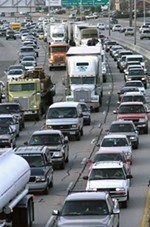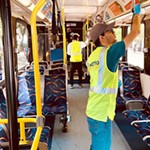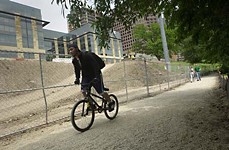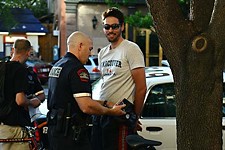Peace and Progress Come to Shoal Creek
Feud between cyclists and residents comes to an end
By Daniel Mottola, Fri., Jan. 14, 2005
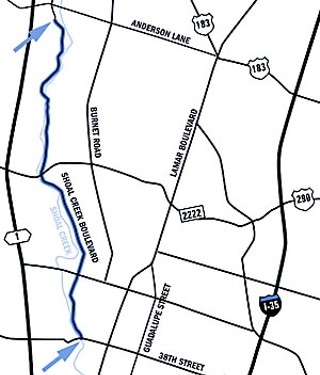
After five years of conflict, a smackdown from the mayor pro tem, and something called a charrette, everyone involved in the Shoal Creek Boulevard Transportation Project has finally agreed on a set of improvements for the scenic Allandale-Rosedale artery. What began as a routine restriping initiative – later expanded to help "calm" traffic and better accommodate cyclists and pedestrians – escalated into a four-year grudge match among residents, bicycle advocates, and city transportation staff. When the dust finally cleared in December, a unique beast had emerged. The final plan – which includes 37 crape-myrtle-adorned, six-foot curb extensions placed at selected intersections, two 10-foot motor vehicle lanes, and two 10-foot shared bike, pedestrian, and parking lanes – is a mutant even its own parents don't entirely applaud. "It's a true compromise," said city project manager Keri Juarez, who was assigned to the project in September. "No one loves it, but everyone can agree on it."
"Or everyone's willing to stop fighting about it," responded Allandale resident Jeb Boyt, who's also president of bike advocacy group Austin Metro Trails and Greenways. The improvement project runs from 38th Street to Foster Lane, and the contractors, Jay-Reese Contractors Inc., say construction should last about four to five months.
In July of 2000, Shoal Creek Boulevard was selected for one of many city street restriping projects aimed at integrating more bike lanes into existing roads. The original plan added a bike lane on one side of the street, thereby eliminating or restricting parking on only that side. But residents erupted at the thought of losing the right to park on the street, and cyclists were equally adamant about an adequate bike lane. It became obvious that conventional solutions simply wouldn't do, and the more meetings the city held, the more stakeholder requests surfaced. Participants asked planners to slow speeding traffic and cut down on high-speed passing on the primarily residential street, and also to address the intermittent lack of sidewalks. By 2001, things hadn't gotten much friendlier, but they were definitely a lot more complicated.
Mayor Pro Tem Jackie Goodman then became involved, by way of a March 2001 City Council resolution directing the city manager to conduct a transportation analysis, to bring the Urban Transportation Commission aboard, and to include input from a public charrette (planning focus group involving all the stakeholders). A year later, the cyclist and resident charrette rejected the city transportation staff's proposal (quite similar to the unpopular initial plan) for 11-foot vehicle lanes and a 7-foot bike lane on one side. Opponents again cited the loss of parking, and the lack of both pedestrian improvements and traffic-calming efforts.
In April of 2002, in an effort to salvage the ailing project, the city hired nationally renowned local traffic consultant Charles Gandy of Livable Communities Consulting. "Soon after he got involved, we started moving toward the solution," said longtime project adviser Stuart Werbner, a South Austin resident who uses Shoal Creek for his daily bicycle commute to 183 and Burnet. By fall of 2002, residents and bikers had agreed to a locally unprecedented solution: extra-wide multipurpose lanes on both sides of the street, to be shared by parked cars, walkers, and cyclists. But city staff refused to approve the concept, citing safety and liability concerns because the bike lanes didn't meet standard width guidelines. Bike advocate Eric Anderson remembers one public meeting in which transportation staff told attendees that "no engineer in our office will sign off on this plan." Now, a new rivalry was in place: Gandy, the stakeholders, and Goodman facing off against the city transportation planning staff.
The situation climaxed in a tense exchange between Goodman and city transportation planners at an overflowing
winter 2002 meeting. Jackie calmly made it very clear that city staff wasnt doing their job, Anderson said. Goodman later wrote a letter to city management citing inappropriate tactics on the part of transportation staff. They had become activists, lobbying the Urban Transportation Committee and City Council to reject Gandys proposal, said Goodman. She said she hoped staff would break out of the box in considering the plan, noting the multitude of problems the project was asked to address.
Ultimately Goodman's efforts paid off, recruiting city management's influence in gaining final approval for Gandy's plan. "Maybe we had to go over staff's head a little," said Paul Nagy, a Shoal Creek Boulevard resident who was involved throughout the project's planning. "Rather than one stakeholder or committee overruling everyone else, our hope is that city staff will take the lessons learned here and apply them to other projects." Groundbreaking is expected within a month, and it appears that area residents, bicyclists, and city planners at least have something they can agree to disagree on: an original, multimodal transportation design that could become a model for effectively reshaping Austin's urban roadways for all kinds of users.
*Oops! The following correction ran in our January 21, 2005 issue: In last week's news story, "Peace and Progress Come to Shoal Creek," Daniel Mottola incorrectly reported that a 2000 city restriping plan for Shoal Creek Boulevard proposed the addition of one bike lane, when in actuality the plan suggested adding two bike lanes, one on either side. The Chronicle regrets the error.
Got something to say on the subject? Send a letter to the editor.





